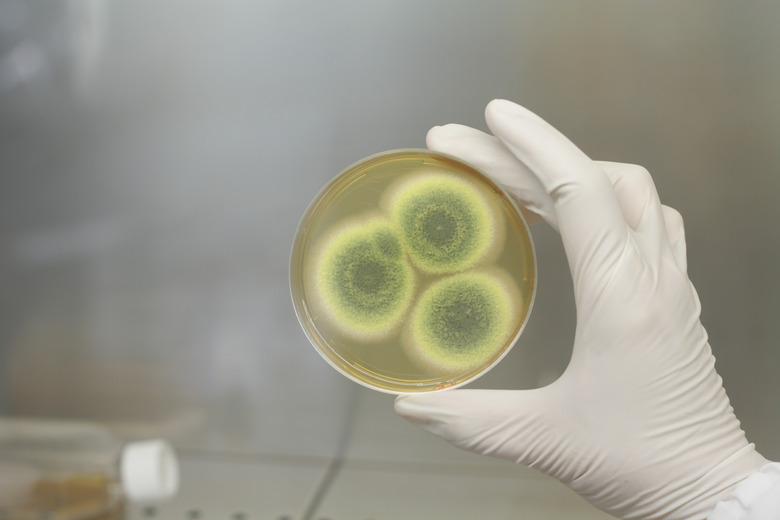The Difference Between A Sporophyte And Gametophyte
In all plants and some algae, an alteration of generations exists in which the species have diploid and haploid phases. Sexual reproduction results in gametes that combine two cells from different individuals. Meiosis also produces gametes. Haploids contain one set of chromosomes in each of their cells. Diploids cells contain two chromosome sets. For plants, haploid and diploid cells divide via mitosis. The plants' haploid phase is called the gametophyte, and the diploid phase is called the sporophyte. Offspring alternate from diploid sporophytes to haploid gametophytes and back again in generations. This means plants generate two different kinds of plants with the same genetic material.
TL;DR (Too Long; Didn't Read)
Plants exist in alternation generations called sporophytes and gametophytes. Sporophytes represent the diploid phase of plants. Gametophytes represent the haploid phase of plants.
Characteristics of Sporophytes
Characteristics of
Sporophytes
Sporophytes are diploid plants that use meiosis to produce spores. These spores are haploid cells that grow into haploid gametophytes. Megaspores grow into female gametophytes, and microspores grow into male gametophytes. Meiosis occurs in the sporangium of a sporophyte and results in haploid spores. These spores contain one cell that can become another new plant without mating. Sporophytes have evolved in vascular plants to become larger, more dominant and longer-lived compared to gametophytes.
Characteristics of Gametophytes
Characteristics of
Gametophytes
Gametophytes are haploid plants that use mitosis to make haploid gametes. These gametes are female in the form of an ovum (egg) or male in the form of sperm. Gametophytes contain the archegonium, or female sex organ, or they contain the antheridium, or male sex organ. The sperm and egg unite in the archegonium to produce a diploid zygote cell. That zygote becomes a sporophyte. Vascular plant gametophytes tend to be much smaller than sporophytes, sometimes even only a few cells in size. A pollen grain represents an example of a male gametophyte in vascular plants.
Non-vascular vs. Vascular Plants
Non-vascular vs.
Vascular Plants
Vascular and non-vascular plants display interesting differences between their sporophytes and gametophytes. Vascular plants do not require as much water to thrive, and they display their large, long-lived sporophyte phase as the actual plant. Gymnosperms such as conifers contain a bit of female gametophyte tissue in their cones, such as pine nuts. Those nuts contain the embryonic diploid sporophyte. The male conifer gametophyte exists as pollen, which is wind-dispersed. For flowering plants such as fruit trees and flowers, female gametophytes contain a few cells and reside inside the ovary of the flower; the male exists as pollen. The small gametophytes of vascular plants only live for a season. Vascular plants that make two kinds of spores and gametophytes are called heterosporic.
Non-vascular plants such as bryophytes (which include mosses, liverworts and hornworts) display different characteristics for their gametophytes and sporophytes. Bryophytes comprise the oldest land plants on the planet, having existed for over 400 million years. They require wetter locales for their reproductive success. Their sporophytes are not visibly dominant. However, their gametophyte generation is the noticeable, photosynthetic part of the plant (like green moss) that attaches to substrates via rhizoids rather than the diploid sporophyte. In fact, their sporophytes are not as long-lived as in vascular plants. The sporophyte forms from a fertilized egg inside the flask-like archegonium and attaches to the gametophyte via a penetrating foot. The sporophyte receives nourishment from the gametophyte. The sporophyte forms a very small stalk called a seta and a single sporangium. A protective covering called a calyptra surrounds this embryonic sporophyte. Single-celled spores travel via wind and germinate only in a moist area; water is required for fertilization. Then they form a new gametophyte plant, which creates more spores in the sporophyte cycle. Because they make just one type of spore and gametophyte, these non-vascular plants are called homosporic.
Genetic Controls of Generation Processes
Genetic Controls of
Generation Processes
Scientists continue to learn more alternating generations in plants. Genetic studies of mosses reveal that a group of proteins called KNOX help drive development of sporophytes. In the angiosperm Arabidopsis thaliana, the PKL gene is needed for maternal sporophytes to promote male and female gametophyte development. Continued research yields even more fascinating aspects of the complex nature of sporophyte and gametophyte generation processes.
References
- University of Miami Department of Biology: Alternation of Generations
- University of Miami Department of Biology: Homology in the Alternation of Generations
- Southern Illinois University Carbondale: Bryophytes
- Rocky Mountain National Park: Mosses & Liverworts
- Genetics: Cross-Talk Between Sporophyte and Gametophyte Generations Is Promoted by CHD3 Chromatin Remodelers in Arabidopsis Thaliana
- Australian National Herbarium: Sporophyte Development
- Scientific American: Mosses Make Two Different Plants From the Same Genome, and a Single Gene Can Make the Difference
Cite This Article
MLA
Hermance, Dianne. "The Difference Between A Sporophyte And Gametophyte" sciencing.com, https://www.sciencing.com/difference-between-sporophyte-gametophyte-8491200/. 11 July 2019.
APA
Hermance, Dianne. (2019, July 11). The Difference Between A Sporophyte And Gametophyte. sciencing.com. Retrieved from https://www.sciencing.com/difference-between-sporophyte-gametophyte-8491200/
Chicago
Hermance, Dianne. The Difference Between A Sporophyte And Gametophyte last modified March 24, 2022. https://www.sciencing.com/difference-between-sporophyte-gametophyte-8491200/
